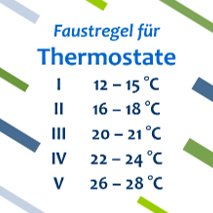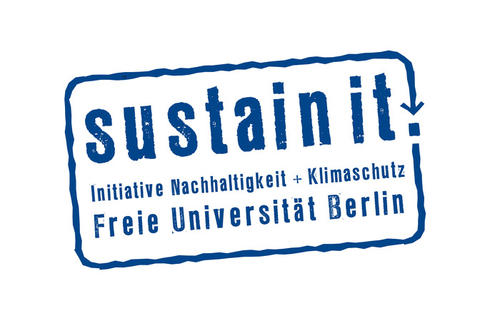Tips for Energy Saving
In heating and electricity consumption, significant energy savings can usually be achieved with small adjustments. Read here how to implement these in your daily work routine.
- Between September 1, 2022, and February 2023, stricter energy-saving regulations were in place for public properties against the backdrop of the energy crisis (room temperature set to 19 degrees). All heating systems were reset to their previous basic settings at the end of these regulations in the first quarter of 2023.
- The optimal temperature is 20 degrees. This typically corresponds to setting 3 on a thermostat scale. However, you can save even more energy by turning down the thermostat when leaving your room. Overnight or on weekends, temperatures of 18 or 16 °C (setting 2.5 to 2) are sufficient. The normal temperature is quickly restored the next morning. This is particularly applicable to rooms where multiple people gather, such as seminar rooms.
- If you plan to be away for several days, you can also reduce the thermostat valves to position 1 or 1.5 (= 12 to 14 °C). In this case, it's advisable to coordinate with your colleagues to ensure the thermostat is adjusted back to a higher setting before your return.
- Avoid placing furniture directly in front of radiators, as it disrupts air circulation in the room.
- Wearing warm clothing in winter helps prevent rapid cooling.
-
Keep windows and doors closed - especially when the ventilation is running. This keeps the heat in the room.
The heating water temperature varies depending on the outside temperature. This means that radiators are not as warm when the outside temperature is higher compared to lower outside temperatures. You can set your desired temperature with the thermostat control on the radiator. A temperature sensor in the thermostat compares this with the room temperature and heats the radiator accordingly. Once the temperature is reached, the thermostat valve shuts off the flow to the radiator. The settings on the thermostat only represent the target temperature: your room will not warm up faster if the thermostat control is turned all the way up.

Example: If the room temperature is 16 °C and your desired temperature is 20 °C, it doesn't matter whether you set the valve to 3 or 5; the temperature of 20 °C will be reached at the same time. Setting it to 3 helps avoid unnecessary overheating of the room.
- Mechanical ventilation (e.g., in lecture halls and laboratories) is particularly energy- and cost-intensive. The air not only needs to be heated or cooled but also requires significant effort (with the help of pumps) to be circulated. Therefore, only use ventilation systems when absolutely necessary. Reducing ventilation runtimes not only saves on heating and cooling but also results in electricity savings.
- In normally heated rooms (e.g., offices), intermittent ventilation is more efficient and energy-saving than leaving windows slightly open. In this case, windows should be fully opened 2-3 times a day for 4-10 minutes.
- When ventilating, always turn down the thermostat controls! Otherwise, you are essentially heating the outdoors through the open window.
- Proper ventilation is crucial as it supports health and concentration.
- Switch on your office and laboratory equipment, as well as lighting, only when you really need them.
- If multiple devices are connected to a power strip, you can centrally disconnect all devices from the power when leaving or not in use.However, never connect multiple power strips in succession - fire hazard!
- Closing unnecessary programs reduces the power consumption of PCs and laptops and makes them run faster.
- Often, the screen is set brighter than necessary. The darker it is, the less energy it consumes.
- Optimize the use of daylight. Placing the desk in front of a window means less reliance on overhead lighting. The desk should be positioned at a right angle to the window to protect the eyes.
- When leaving the room, turn off the lights. With modern light sources, repeated switching on and off no longer consumes additional energy.
- On hot summer days, the most effective way to ventilate is with a draft in the cooler morning hours. Coordinate with your colleagues so that the draft can take place as early as possible. Then, close the windows and use sun protection.
- Heat primarily enters indoor spaces through unprotected windows. Sun protection and blinds effectively shield the heat from the sun's rays. The most effective option is an external sunshade.
- If possible, schedule work hours during cooler periods and in cooler rooms. Check if you can swap rooms within a department. Temperature differences between northern and southern parts of buildings are generally significant.
- Many running devices continue to heat the room. Therefore, turning off unnecessary electrical devices helps.
- Fans are only useful when there is no option for a draft. Fans increase the room temperature with their waste heat. Only the airflow is perceived as pleasant. Natural ventilation, on the other hand, lowers the room temperature and saves energy.
- Avoid opening windows during the hottest hours. Otherwise, you won't have a way to get rid of the incoming heat.
- Important: Stay well-hydrated during high temperatures!
If you encounter issues with the heaters, please contact the central control room (55555).
Did you know that...?
- Lowering room temperature by one degree saves about 4-6% energy?
- Maintaining a temperature of 20°C instead of 22°C can save approximately 10% on energy costs?
- Since 2010, Freie Universität has sourced 100% CO2-free electricity?
- FU practices a bonus scheme for energy savings?




